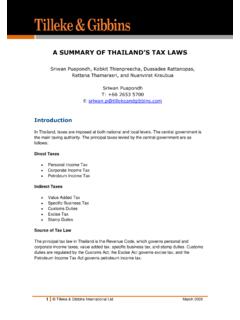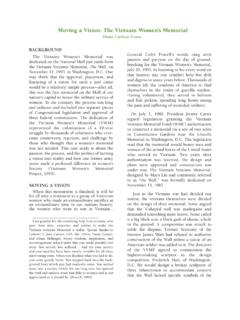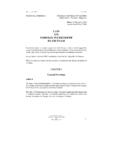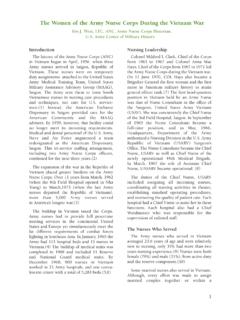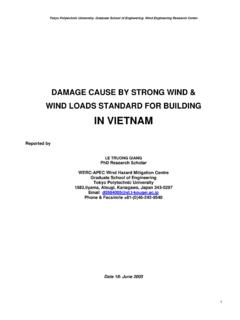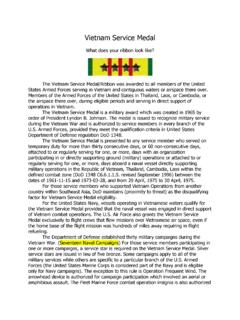Transcription of AN OVERVIEW OF VIETNAM LABOR LAW HIRING …
1 Left Thomas J. Treutler Right Trinh Trung Kien AN OVERVIEW OF VIETNAM LABOR LAW. This article provides a comprehensive introduction to VIETNAM LABOR law, including information on HIRING an employee, maintaining the employment relationship, modifying the employment relationship, and terminating the employment contract. HIRING THE EMPLOYEE. Main Sources of Employment Law The main sources of employment law in VIETNAM are: 1. the LABOR Code (adopted by the National Assembly of VIETNAM on June 23, 1994, as amended on April 2, 2002, November 29, 2006, and April 2, 2007);. 2. the Law on Sending Vietnamese Laborers to Work Overseas (adopted by the National Assembly of VIETNAM on November 29, 2006);. 3. government decrees, ministerial circulars and decisions, provincial decisions and guidelines;. 4. collective LABOR agreements, company rules, individual contracts; and 5. the Supreme Court's annual practice summaries and guidelines.
2 (collectively referred to as, LABOR Law ). Vietnamese LABOR Law applies to all individuals working for VIETNAM -based organizations or Vietnamese individuals, regardless of their nationality. Basic contractual law and enterprise ( , corporate) law provisions may also govern certain matters. Normally, Vietnamese LABOR Law is also applied when Vietnamese companies send their employees to work overseas, per the Law on Sending Vietnamese Laborers to Work Overseas. Technically, the employment contract need not specify this choice of law. Special HIRING Considerations HIRING Non-Nationals In general, if an expatriate wants to work in VIETNAM for three months or longer, he/she must 1 Tilleke & Gibbins Consultants Limited November 2010. obtain a work permit. Vietnamese employers are required to provide support and submit application documents for the work permit. HIRING Specified Categories of Individuals Employers are prohibited from employing female employees, pregnant employees, child employees, and old employees for hazardous and hard work that may cause health problems.
3 Normally, the minimum working age is 15. There is no restriction on the maximum working age. The daily working hours of senior workers (over 60 for men or over 55 for women), however, should be reduced. Outsourcing and/or Subcontracting There is no clear definition of outsourcing or subcontracting under the Vietnamese LABOR Code. The LABOR Code contains an inflexible provision stating that a LABOR contract must be directly entered into by an employer and an employee. In addition, the tasks stipulated in the LABOR contract must be carried out by the employee under his/her LABOR contract; the transfer of such tasks to another person must be approved by the employer. In practice, if an employer wishes to use a LABOR outsourcing service, he/she will not enter into a direct LABOR contract with workers, but will enter into a LABOR outsourcing service agreement with the service provider. Basic Employment Terms A LABOR contract must be written in Vietnamese or in both Vietnamese and the foreign language that is applicable to the employer and employee.
4 Contracts for temporary jobs lasting less than three months or for domestic helper work do not need to be in writing and can be oral. The LABOR Code of VIETNAM requires that a LABOR contract include the following material terms: (i) work to be performed; (ii) working hours and rest hours; (iii) wages; (iv) working place/location; (v) duration of contract; (vi) conditions on occupational safety and hygiene; and (vii) social insurance for the employee. In practice, statutory material terms are for standard LABOR contracts for simple work only. Working Hours and Rest Hours The maximum working hours are eight hours per day or 48 hours per week for normal working conditions. Daily working hours must be reduced by one or two hours for employees subject to extremely heavy, dangerous, or toxic working conditions. Employees must take a rest period of a minimum of 24 consecutive hours per week. There are also various compulsory daily and weekly rest periods and breaks that must be observed.
5 Wages Employees may not earn an amount below the minimum salary level, which is reviewed from time to time. Different minimum levels exist and depend on the location of the workplace. 2 Tilleke & Gibbins Consultants Limited November 2010. Working Place/Location An employee's place of work must be stated in the LABOR contract. Mobility clauses can be included in employees' LABOR contracts, if necessary. Where a job requires travel to other temporary locations, it is normal for employers to reimburse all reasonable travel expenses. Duration of the Contract Under the LABOR Code of VIETNAM there are three types of LABOR contracts: (i) an indefinite-term LABOR contract; (ii) a fixed-term LABOR contract with duration of 12 to 36 months; and (iii) a LABOR contract for a specific or seasonal job of less than 12 months. Conditions on Occupational Safety and Hygiene Employers are required to provide employees with sufficient protective equipment to ensure occupational safety and hygiene and to improve working conditions in the workplace.
6 Employees must comply with occupational safety and hygiene regulations and the internal LABOR rules of employers. Social Insurance and Leave Compulsory Social Insurance applies to enterprises, entities, and organizations that employ employees under indefinite-term LABOR contracts or under definite-term LABOR contracts with a duration of three months or more. Both employees and employers are required to contribute to the social insurance fund at statutory rates. The social insurance fund pays allowances for sick leave, maternity leave, work-related accidents, occupational disease, and pensions. Sick Leave Employees who suffer from illness and/or disability or take leave in accordance with a doctor's order receive an allowance paid by the social insurance fund, provided that they submit the required documentation evidencing their leave. The sick leave allowance is based on the employee's salary used to calculate the social insurance premium.
7 The maximum entitlement is: 30 days per year (if the employee contributes to the social insurance fund for less than 15 years) or 40 days per year (if the employee contributes to the social insurance fund for between 15 and 30 years) or 60 days per year (if the employee contributes to the social insurance fund for more than 30 years). Maternity Leave Employers must allow pregnant workers to have their health checked regularly. A female employee (who works in normal working conditions) is normally entitled to take four months'. maternity leave. If the female employee works in heavy and/or harmful working conditions or works in a remote location, she is entitled to take up to six months' maternity leave. Where an employee gives birth to more than one child at one time, she is entitled to take an additional 30. days' leave for every additional child calculated from the second child onwards. The employee will receive a maternity allowance from the social insurance fund during maternity leave.
8 3 Tilleke & Gibbins Consultants Limited November 2010. Accidents at Work Work-related accidents are defined as accidents that injure any bodily parts or functions of an employee or cause the employee's death during the process of working and closely relate to work performance or LABOR activity. An employee who is injured in a work-related accident must be immediately treated and be fully attended to. The employer must take full responsibility for the occurrence of the work-related accident. During the period in which an employee is absent from work for medical treatment related to a work-related accident or occupational disease, the employer must pay the employee his/her full salary and expenses for the treatment. After the treatment, the employee will be examined and assigned a category of injury, which depends on the reduction of his/her ability to work due to the work-related accident or disease. The employee will be entitled to a social insurance benefit paid as a lump sum or in monthly installments by the social insurance fund.
9 Pension Plans There is no scheme for pension plans under Vietnamese LABOR Law. Both employers and employees are required to contribute to the compulsory social insurance fund that pays pensions to employees when they retire. Absence for Military or Public Service Duties Employees are entitled to suspend performing their duties under LABOR contracts if they are required to carry out military service or other public civic obligations. Employers are required to reemploy the employees at the end of the suspension period. Noncompulsory Contract Terms Employers and employees are free to agree any other terms in addition to the compulsory provisions, provided that these terms are no less favorable than certain statutory rights and must not be contrary to social morals. Trial Period There is no compulsory obligation to provide trial periods, otherwise known as probationary periods, when engaging new employees, but it is common in practice to do so.
10 A probationary period must not exceed 60 days for work that requires specialized or highly technical skills or 30. days for other types of work. Training Obligations In general, employers have no statutory obligation to train their employees. In certain cases, however, such as reorganization or change of technology, employers are required to retrain their employees. Secrecy/Confidentiality There is no specific statute governing secrecy and confidentiality. An employee is generally required to protect trade secrets and/or confidential information of his/her employer. If an employee fails to do so, the employee may be subject to a LABOR disciplinary hearing and disciplinary action. 4 Tilleke & Gibbins Consultants Limited November 2010. Ownership of Inventions and Other Intellectual Property Rights The employer owns all inventions and other intellectual property rights created by employees, unless there is an agreement that states otherwise between the employee and the employer.
